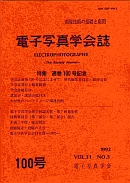Volume 33, Issue 1
Displaying 1-11 of 11 articles from this issue
- |<
- <
- 1
- >
- >|
Original Articles
-
1994Volume 33Issue 1 Pages 2-6
Published: 1994
Released on J-STAGE: May 31, 2007
Download PDF (1454K) -
1994Volume 33Issue 1 Pages 7-14
Published: 1994
Released on J-STAGE: May 31, 2007
Download PDF (3091K) -
1994Volume 33Issue 1 Pages 15-20
Published: 1994
Released on J-STAGE: May 31, 2007
Download PDF (1155K) -
1994Volume 33Issue 1 Pages 21-27
Published: 1994
Released on J-STAGE: May 31, 2007
Download PDF (1246K)
Imaging Today
-
1994Volume 33Issue 1 Pages 29-34
Published: 1994
Released on J-STAGE: May 31, 2007
Download PDF (1486K) -
1994Volume 33Issue 1 Pages 35-37
Published: 1994
Released on J-STAGE: May 31, 2007
Download PDF (424K) -
1994Volume 33Issue 1 Pages 38-42
Published: 1994
Released on J-STAGE: May 31, 2007
Download PDF (969K) -
1994Volume 33Issue 1 Pages 43-49
Published: 1994
Released on J-STAGE: May 31, 2007
Download PDF (1173K) -
1994Volume 33Issue 1 Pages 50-56
Published: 1994
Released on J-STAGE: May 31, 2007
Download PDF (3061K) -
1994Volume 33Issue 1 Pages 57-65
Published: 1994
Released on J-STAGE: May 31, 2007
Download PDF (3204K) -
1994Volume 33Issue 1 Pages 66-70
Published: 1994
Released on J-STAGE: May 31, 2007
Download PDF (1213K)
- |<
- <
- 1
- >
- >|
